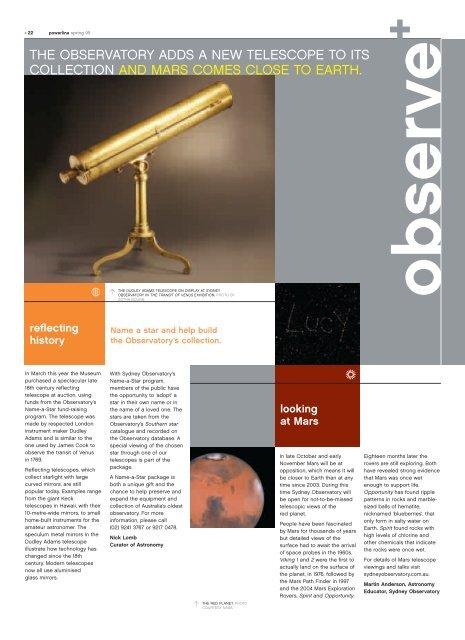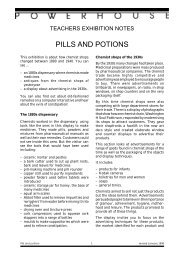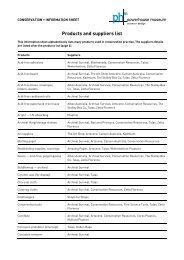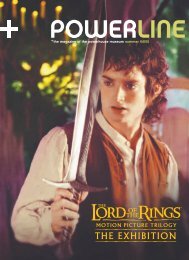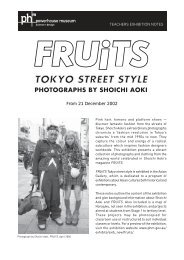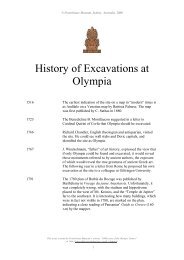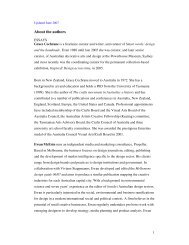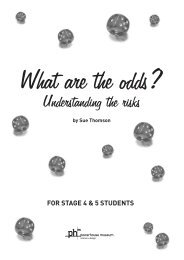design across time - Powerhouse Museum
design across time - Powerhouse Museum
design across time - Powerhouse Museum
Create successful ePaper yourself
Turn your PDF publications into a flip-book with our unique Google optimized e-Paper software.
+ 22 powerline spring 05<br />
THE OBSERVATORY ADDS A NEW TELESCOPE TO ITS<br />
COLLECTION AND MARS COMES CLOSE TO EARTH.<br />
reflecting<br />
history<br />
�<br />
In March this year the <strong>Museum</strong><br />
purchased a spectacular late<br />
18th century reflecting<br />
telescope at auction, using<br />
funds from the Observatory’s<br />
Name-a-Star fund-raising<br />
program. The telescope was<br />
made by respected London<br />
instrument maker Dudley<br />
Adams and is similar to the<br />
one used by James Cook to<br />
observe the transit of Venus<br />
in 1769.<br />
Reflecting telescopes, which<br />
collect starlight with large<br />
curved mirrors, are still<br />
popular today. Examples range<br />
from the giant Keck<br />
telescopes in Hawaii, with their<br />
10-metre-wide mirrors, to small<br />
home-built instruments for the<br />
amateur astronomer. The<br />
speculum metal mirrors in the<br />
Dudley Adams telescope<br />
illustrate how technology has<br />
changed since the 18th<br />
century. Modern telescopes<br />
now all use aluminised<br />
glass mirrors.<br />
THE DUDLEY ADAMS TELESCOPE ON DISPLAY AT SYDNEY<br />
OBSERVATORY IN THE TRANSIT OF VENUS EXHIBITION. PHOTO BY<br />
SOTHA BOURN.<br />
Name a star and help build<br />
the Observatory’s collection.<br />
With Sydney Observatory’s<br />
Name-a-Star program,<br />
members of the public have<br />
the opportunity to ‘adopt’ a<br />
star in their own name or in<br />
the name of a loved one. The<br />
stars are taken from the<br />
Observatory’s Southern star<br />
catalogue and recorded on<br />
the Observatory database. A<br />
special viewing of the chosen<br />
star through one of our<br />
telescopes is part of the<br />
package.<br />
A Name-a-Star package is<br />
both a unique gift and the<br />
chance to help preserve and<br />
expand the equipment and<br />
collection of Australia’s oldest<br />
observatory. For more<br />
information, please call<br />
(02) 9241 3767 or 9217 0478.<br />
Nick Lomb<br />
Curator of Astronomy<br />
THE RED PLANET. PHOTO<br />
COURTESY NASA.<br />
looking<br />
at Mars<br />
a<br />
In late October and early<br />
November Mars will be at<br />
opposition, which means it will<br />
be closer to Earth than at any<br />
<strong>time</strong> since 2003. During this<br />
<strong>time</strong> Sydney Observatory will<br />
be open for not-to-be-missed<br />
telescopic views of the<br />
red planet.<br />
People have been fascinated<br />
by Mars for thousands of years<br />
but detailed views of the<br />
surface had to await the arrival<br />
of space probes in the 1960s.<br />
Viking 1 and 2 were the first to<br />
actually land on the surface of<br />
the planet, in 1976, followed by<br />
the Mars Path Finder in 1997<br />
and the 2004 Mars Exploration<br />
Rovers, Spirit and Opportunity.<br />
observe +<br />
Eighteen months later the<br />
rovers are still exploring. Both<br />
have revealed strong evidence<br />
that Mars was once wet<br />
enough to support life.<br />
Opportunity has found ripple<br />
patterns in rocks and marblesized<br />
balls of hematite,<br />
nicknamed ‘blueberries’, that<br />
only form in salty water on<br />
Earth. Spirit found rocks with<br />
high levels of chlorine and<br />
other chemicals that indicate<br />
the rocks were once wet.<br />
For details of Mars telescope<br />
viewings and talks visit<br />
sydneyobservatory.com.au.<br />
Martin Anderson, Astronomy<br />
Educator, Sydney Observatory


